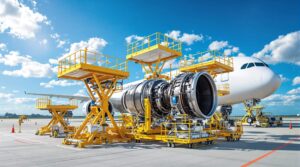The structure of plane wheels embodies a sophisticated design, incorporating a fusion of robust materials like aluminum alloys, steel, and advanced composite materials. This amalgamation ensures optimal strength-to-weight ratio, vital for enduring the tremendous pressures during touchdown and liftoff.
One pivotal aspect of these wheels is their ability to distribute weight evenly. As the aircraft taxis, takes off, or lands, the wheels bear the immense weight of the plane, diffusing it across the landing gear and the runway. This even distribution is critical in preventing excessive stress on any singular point, thereby averting potential structural damage.
Wheels on a plane undergo meticulous maintenance and inspection schedules. Each wheel undergoes rigorous checks for any signs of wear, tear, or potential defects. Advanced diagnostic techniques like ultrasonic testing and magnetic particle inspections ensure any potential issues are detected early, ensuring optimal safety standards.
Moreover, the tires on these wheels are engineered with specialized tread patterns and materials to provide optimal traction during landing and takeoff. They are designed to withstand high speeds, varying temperatures, and different runway conditions, ensuring a secure grip even in adverse weather scenarios.
| Key Functions of Plane Wheels: | |
|---|---|
| 1. Load Bearing: | Supports the weight of the aircraft during takeoff, landing, and taxiing. |
| 2. Weight Distribution: | Ensures even distribution of the plane’s weight to prevent structural stress. |
| 3. Durability: | Constructed with robust materials to withstand high pressures and forces. |
| 4. Traction: | Engineered tires provide optimal grip on various runway surfaces. |
In essence, the wheels on a plane are not mere components but vital mechanisms that contribute profoundly to the safety and efficiency of air travel. Their intricate design, meticulous maintenance, and pivotal role in handling the aircraft’s weight make them an essential part of every flight’s smooth operation.
Plane wheels assembly and maintenance
When it comes to the intricate dance of engineering that keeps airplanes soaring through the sky, one often overlooked but critical component is the plane wheels assembly and maintenance. Ensuring the seamless operation of an aircraft involves a complex network of parts, and the wheels are undoubtedly among the unsung heroes of aviation.
The wheel assembly of an airplane is a marvel of precision engineering. Comprising the wheel itself, tire, brakes, and various associated components, this assembly is designed not only to support the aircraft’s weight but also to handle the immense forces experienced during takeoff, landing, and taxiing. The wheels must endure extreme conditions, from scorching tarmacs to freezing altitudes, making their construction and maintenance a meticulous affair.
One crucial aspect of plane wheel maintenance is tire inspection and replacement. Aircraft tires, constructed from specialized rubber compounds, must be regularly checked for wear, damage, and proper inflation. A routine inspection involves assessing tread depth, looking for signs of uneven wear, and ensuring that the tire pressure meets the manufacturer’s specifications. Any deviation from these parameters can compromise the aircraft’s safety and performance.
Moreover, the brake system associated with the wheels requires meticulous attention. Aircraft brakes are typically hydraulically operated and play a pivotal role during landing and taxiing. Brake pads, disks, and hydraulic lines must be inspected regularly, and any signs of wear or fluid leaks demand immediate attention. The braking system is not only vital for the safety of the aircraft but also influences the overall efficiency of ground operations.
In addition to routine maintenance, aircraft wheels may undergo overhaul procedures at specified intervals. This involves disassembling the wheel assembly, inspecting each component thoroughly, and replacing any parts that have reached the end of their service life. The overhaul process is a comprehensive examination that ensures the airworthiness of the entire wheel assembly.
Furthermore, corrosion prevention is a key consideration in plane wheel maintenance. Given the varied environments an aircraft operates in, corrosion can pose a significant threat to the structural integrity of wheels. Protective coatings, regular cleaning, and corrosion inspections are integral to mitigating this risk.
Table:
| Component | Maintenance |
|---|---|
| Tires | Regular inspection, tread depth check, pressure monitoring |
| Brake System | Periodic checks, inspection of pads, disks, and hydraulic components |
| Overhaul | Comprehensive examination and replacement of worn parts |
| Corrosion Prevention | Protective coatings, regular cleaning, corrosion inspections |
Plane wheel steering mechanism
When it comes to the intricate dance of an aircraft on the ground, the nosewheel plays a pivotal role in orchestrating the movements during taxiing. Unlike the main landing gear wheels, the nosewheel is strategically positioned at the front of the aircraft, directly beneath the cockpit. This positioning enables it to respond promptly to steering commands, facilitating precise control during ground operations.
The nosewheel steering mechanism is a marvel of aviation engineering, allowing for dynamic and nuanced control. This mechanism is typically hydraulically powered, responding to the pilot’s input through the cockpit’s steering control. As the pilot turns the control wheel, hydraulic actuators engage, directing the nosewheel accordingly. This responsive system is essential for navigating the aircraft with finesse, especially in crowded airport aprons and taxiways.
Complementing the nosewheel in ground control is the aircraft’s rudder, an aerodynamic surface usually found on the vertical stabilizer at the rear. While the rudder primarily influences the aircraft’s yaw during flight, its ground operation significance lies in its contribution to steering during taxiing. Some aircraft incorporate a system known as a steerable nosewheel, where the rudder is linked to the nosewheel steering, providing an additional means of control.
During taxiing, the pilot utilizes a combination of steering inputs, manipulating both the nosewheel and, if applicable, the rudder. This intricate coordination is crucial, especially when navigating tight turns or aligning the aircraft with runways or parking positions. The nosewheel‘s agility ensures that the aircraft responds promptly to directional changes, making ground movements seamless and efficient.
For a comprehensive understanding of an aircraft’s ground dynamics, it’s essential to recognize the synergy between the nosewheel, rudder, and steering mechanisms. These components work in harmony to provide pilots with the control necessary for precise taxiing. Whether gracefully maneuvering through a bustling airport or aligning with a gate, the integration of these systems exemplifies the precision and sophistication inherent in modern aviation.
Plane wheel retraction system
The plane wheel retraction system is a marvel of engineering, seamlessly integrating hydraulic and pneumatic elements to achieve flawless functionality. At its core, the retractable landing gear is a symphony of precision, allowing aircraft to smoothly transition between ground and flight.
The hydraulic aspect of the system is crucial for its robustness. Hydraulic actuators play a pivotal role in lifting and lowering the landing gear. These powerful mechanisms, driven by hydraulic fluid, provide the necessary force to overcome the gravitational resistance during the retraction process. The hydraulic pressure ensures a reliable and sturdy movement, contributing to the overall safety of the aircraft.
Complementing the hydraulic muscle, the pneumatic components bring agility and efficiency to the retraction process. Pneumatic actuators, relying on compressed air, assist in the swift and controlled folding of the landing gear. This dynamic duo of hydraulic and pneumatic elements ensures that the mechanism operates seamlessly, reducing stress on the structure and extending the lifespan of the entire system.
The retractable landing gear is a masterpiece of mechanical ingenuity. Through a precisely orchestrated mechanism, the landing gear folds into the fuselage with minimal drag, contributing to enhanced aerodynamics during flight. The synchronized dance of hydraulic and pneumatic components within the retraction system is a testament to human engineering prowess.
Let’s delve into the specifics of the mechanism. The retractable landing gear comprises an intricate arrangement of gears, levers, and linkages. These components work in harmony to ensure a swift and reliable retraction process. The hydraulic cylinders act as the powerhouse, initiating the upward movement, while the pneumatic actuators provide the finesse needed for a smooth and controlled retraction.
Structurally, the landing gear assembly is designed to withstand the forces encountered during takeoff and landing. The hydraulic system, with its immense strength, ensures that the landing gear can withstand the impact of touchdown, providing a stable foundation for the aircraft during crucial phases of flight.






